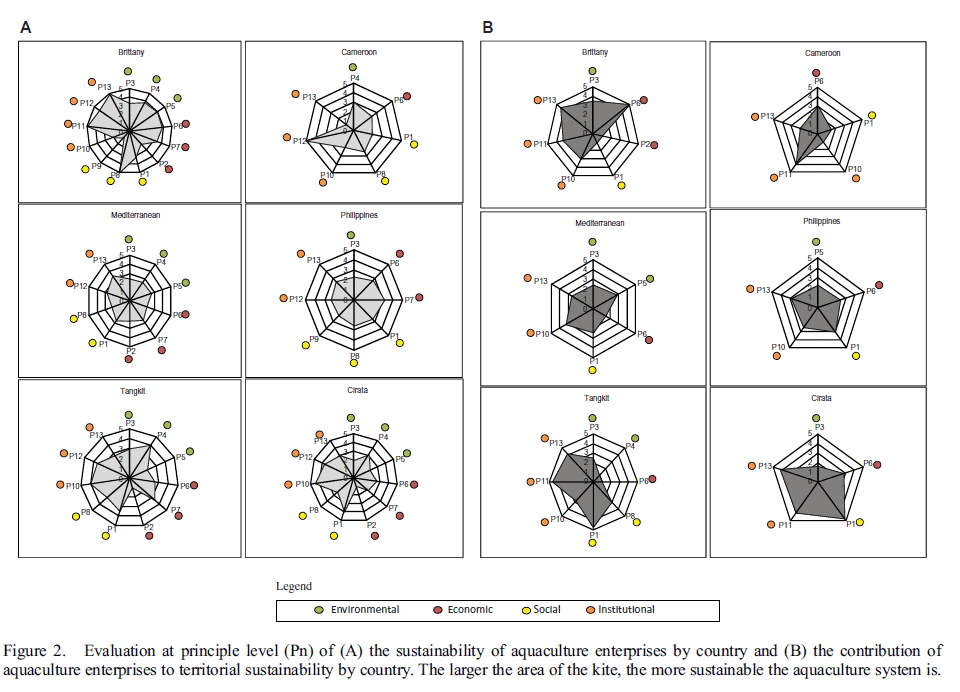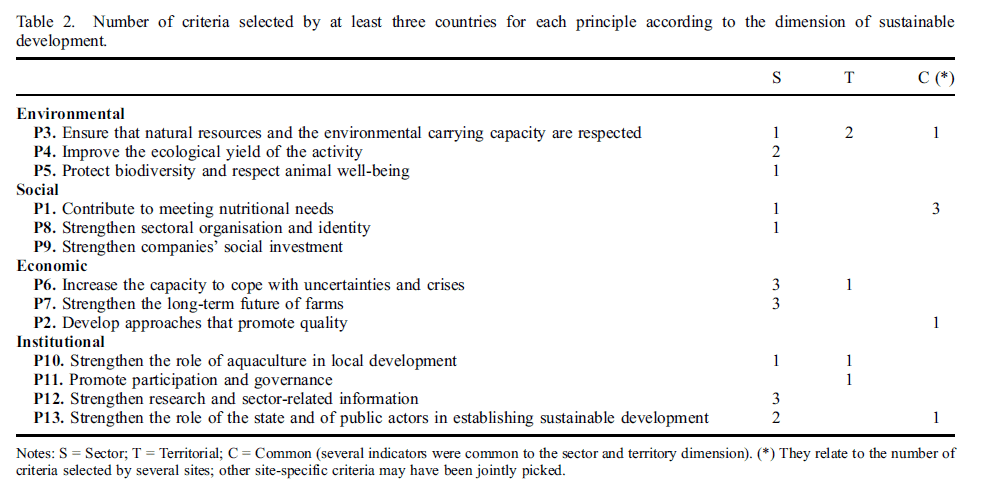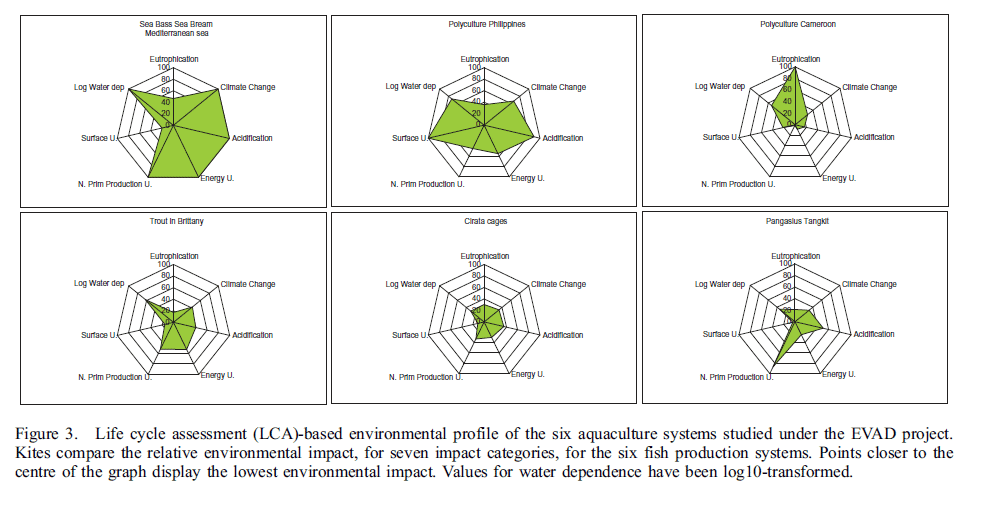In the last 30 years, aquaculture has experienced an unprecedented development in global animal production with an average yearly growth rate of over 10% between 1980 and 2000 (FAO 2010). Over the same period, capture fisheries saw their progression gradually grind to a standstill and growth stopped in 1995.
The growth of aquaculture, despite its benefits and the fact that it is the only way to meet the increase in demand for sea products evaluated at 192–270 Mt in 2050 (Wijkstrom 2003; Merino et al. 2012), raises a certain number of issues directly related to its sustainable development. Feed is a crucial topic that is the subject of significant controversy following the emblematic article by Naylor et al. (2000), which showed the impact on catches of the massive use of fish meal and fish oil in fish and prawn aquaculture and advocated a return to less input-intensive aquaculture systems, directly inspired by traditional Asian systems.
However, farming systems have continued to intensify; this has led to a sustained increase in the use of fish meal and fish oils (Tacon & Metian 2008). Moreover, Naylor et al. (2000) contrast two aquaculture models: first, an input-intensive system, particularly as regards fish meal and oils, considered to be non-sustainable; and second, extensive or semi-intensive system, considered to be sustainable. Approaches taking into consideration the social domain as a sustainability pillar have provided contradictory results.
Various examples that have been studied (Edwards 1999; Irz & Stevenson 2005) show that the fundamental question is whether there are specific aquaculture systems that can contribute to poverty alleviation in parallel with profit-orientated systems. An analysis of the main reference frameworks, such as codes of conduct, guides of good practice, standards, labels (Boyd et al. 2005; FAO 1995; WWF 2008a, 2008b among others), and initiatives for the construction of sustainable development indicators (Consensus 2005; GFCM 2010) in aquaculture, shows that most of them are based on very unbalanced approaches in terms of the dimensions of sustainable development that are taken into account.
Some of them, especially those being implemented on a wide geographical scale, are highly centralised with little reliance on participatory processes (Mathé et al. 2006). According to Bush et al. (2013), certification in aquaculture, as with organic agriculture, follows an enterprise-level approach. Such narrow definitions of sustainability reflect the structure of standard-setting institutions and the feasibility of measurement and regulation using technical parameters. Even the multi-stakeholder processes that are used to develop Aquaculture Stewardship Council standards have been criticised for adopting a technical focus that reflects the interests and values of the most powerful actors to the exclusion of others (Belton et al. 2010).
Our approach has been designed to encompass all the dimensions of sustainability, including the traditional pillars (economic, social and environmental) as well as the institutional one (governance). A distinctive feature of the approach is that it addresses not only the sustainability of fish farms but also the contribution of aquaculture to the sustainability of areas where such farms are established. This additional level provides a link to the ecosystem services provided by aquaculture in accordance with the approach recommended by the Millennium Ecosystem Assessment (MEA 2005) and developed by FAO (2008).
The approach is both multidisciplinary and participatory and compares several countries and types of aquaculture systems, and results in a diagnosis and global recommendations. Lastly, we compared the sustainability approach based on co-construction, with a standardised and normative approach, that is, a Life Cycle Assessment (LCA), in order to evaluate the level of convergence of the conclusions from the two types of assessment. Moreover, our approach is based on the hypothesis that sustainable development is a new reference framework that, in order to be taken on board, requires specific learning processes, the so-called ‘double-loop learning’ of Argyris and Schon (1996).
It is not only practices but also values and objectives that have to be modified and it therefore requires a continuous improvement process, starting from sustainable development values or principles that are deemed to be of the highest priority for producers and stakeholders. Sustainability, as it was conceived and addressed in the work carried out under the Evaluation of aquaculture system sustainability (EVAD) project from 2005 to 2010 (Rey-Valette et al. 2008), is similar to that defined by Tlusty et al. (2012), that is, a continuous process, a ‘journey’ rather than a destination in terms of a sustainable, final and ideal aquaculture product.
Results
The approach was validated in the six aquaculture systems studied under the project. The diagnoses of the sustainability of aquaculture systems were first established for each area (territorial diagnoses, § 3.1), then at global level by developing a synthesis of these diagnoses (into a metadiagnosis, § 3.2). These diagnoses were undertaken at the criterion level, which is the most relevant analytical level to qualify the sustainability factors of these systems, and complemented by the LCA (§ 3.3).
Territorial diagnoses of aquaculture system sustainability
Typologies carried out by area (Lazard et al. 2009, 2010) revealed quite a large diversity in production and regulatory systems.Leaving aside the Tangkit site (Indonesia) where aquaculture systems are very homogeneous, three or four different farm types were identified in each area, regardless of whether or not there was a large number of farms. The global overviews of the sustainability of the various aquaculture systems are presented (Figure 2) at the principle level in order to facilitate comparison. Working at this level made it possible to generate general diagnoses by area which highlighted the strengths and the weaknesses of the relevant aquaculture system.
Meta diagnosis of the aquaculture systems studied
A database was built from the selections made by the actors from the different countries. It comprised 13 principles (Table 2), 64 criteria and 129 indicators (Rey-Valette et al. 2008).Despite system diversity, 10 principles and 25 criteria were common to four of the six areas. The proportion of common indicators was significantly lower with only 30 indicators common to three areas.
Although the technical systems studied in Indonesia were highly differentiated as regards both farming systems (cages and ponds) and aquaculture operators (farmers and entrepreneurs), many criteria were common to the two Indonesian areas of Tangkit and Cirata. This observation tended to show the importance of cultural and institutional aspects for sustainability. Conversely, Cameroon, where aquaculture is struggling to develop, was a particular case which stood out from other areas in terms of principle selection and prioritisation.
This situation tended to indicate that the degree of maturity of the sector was also a determining factor for sustainability. Table 2 presents the number of criteria selected in at least three countries by principle, distinguishing between those relating to farm sustainability, those relating to the evaluation of their contribution to territorial sustainability and those concerning both levels. Furthermore, the analysis of the types of criteria selected according to the area showed that actors tended to select criteria relating to aspects which seemed to them to be problematic. This approach was therefore perceived by them as a management and programming tool to facilitate progress in their aquaculture systems.
This was a different process to labelling approaches or certification schemes which are often linked to marketing strategies and where the emphasis is on strengths in order to build the image of the sector. Considering Figure 2, Brittany proved to be relatively well placed in terms of sustainability with, however, differentiated scores depending on the various principles. On the other hand, the Mediterranean and the Philippines had more regular profiles which showed some homogeneity in the results for all the principles, with no outstanding strengths/constraints. Lastly, Cameroon and Indonesia had, like Brittany, uneven
profiles based on the principles but at a lower level of sustainability. This varying homogeneity in the scores is a fundamental result for defining sector-specific accompanying policies.
Environmental diagnoses of aquaculture systems based on the LCA method
Figure 3 reveals that there was no direct relationship between the level of intensification of the farming system and the level of impact. In particular, the Cirata fish farms in Indonesia (cages) and the bass and bream production in the Mediterranean, also in cages, both were very intensive, but showed a very low level of impact for the former and a very high level for the latter. This might be explained by the species choice (predominantly planktivorous/omnivorous) and the goal of maximum productivity (by associating species: common carp and tilapia) in the first case and by the choice of carnivorous species (bass/bream) and a poor food conversion ratio (FCR) in the second case, which was confirmed by Mungkung et al. (2013).
The markedly lower impact of trout culture (Brittany) might be explained by its low FCR. In the case of polyculture in Cameroon, only two impact categories showed high levels: eutrophication and water dependency, due to the poor capacity of the system to make use of the nutrients provided by the inputs, combined with inadequate water management (Efole Ewoukem et al. 2012). Polyculture impacts were found to be relatively high in the Philippines.
They showed the low productivity of the system; as a result, the quantity of inputs did not produce sufficient output; and the same was true for land and water. In Pangasius fish farms in Tangkit, the predominant impact was the use of net primary production due to excess levels of fish meal (based on local species and trash fish) incorporated into the feed.
Discussion
The ranking of areas with respect to sustainability obtained from the multicriteria evaluation corresponded, in terms of relative priority, to the classification obtained from the results of the LCA. In both cases, Brittany obtained the best scores, whilst more extensive systems, which might have been thought to be closer to natural systems in their environmental dimension and therefore intuitively more ‘sustainable’, scored much lower.
In fact, at the studied sites, it appeared that intensive systems related to situations where farming regulatory and control systems were far more developed and effective. At first sight, the environmental performance evaluated by LCAs was not consistent with the perception that emerged from the diagnoses established on the basis of criteria and principles selected by the actors in the various areas. In particular, the high level of environmental impact found in the Mediterranean cage farming system did not appear at all at farm level but only just at territorial level. This situation may be explained by two characteristics. LCA indicators (impact categories) relate mainly to two levels: a local level (e.g. eutrophication or water use) and a global level (e.g. climate change, acidification or the use of net primary production) or a mixture of the two levels (e.g. energy use). For this reason, actors feel that cages placed in open surroundings where the water resource seems to be endless, like the sea, have no impact on the environment.
In contrast, trout fish farming in Brittany is thought to have a higher impact as it uses fresh water, a natural resource considered to be under threat. As a result, principles relating to territorial carrying capacity and ecological performance at farm level were selected. However, when impacts were calculated in tons of fish, they were lower than those found in Mediterranean marine cages. The Filipino fish farms of Pampanga, which are spread over significant areas and are therefore assimilated to extensive practices, were not considered by actors to have worrying environmental impacts despite high levels of impact on climate change and acidification per ton of fish.
In the case of Cameroon, there was some consistency concerning the hot spot of the system, which was the high release of nutrients into the environment (reflected by the eutrophication indicator). The two Indonesian fish farming systems appeared particularly well optimised and their impact, calculated in tons of product, was low. Nevertheless, worrying environmental impacts remained for these two types of farming.
Generally speaking, these results showed no real concordance between local actors’ preoccupations as defined by the participatory approach and the information produced by LCAs, except indirectly through production system efficiency. They were therefore clearly two complementary evaluation approaches with different spatial levels of preoccupation as actors were not very sensitive to global impacts. Perceptions of environmental issues depended greatly on resource availability, and this was not reflected by the LCA when it was calculated in units of product weight. These findings challenge the use of LCAs in the context of certification or ecolabelling schemes (Mungkung et al. 2006; Pelletier & Tyedmers 2008) as they could lead to standards or communication procedures that are misunderstood or misinterpreted by local producers and decision-makers.
Conclusion
Lessons learnt from the work carried out in the various areas suggested a number of more general conclusions that demonstrated the value of the method.
(1) Combining a participatory and procedural approach with the integration of international reference frameworks proved to be effective. A fair level of learning and appropriation was achieved during the evaluation exercise. Producers considered that the approach adopted (i.e. the co-construction of PCIs) was a management tool that could help in the development of their fish farms. The indicators were used because they were closely related to the farming characteristics in each of the countries. But comparisons were possible at criterion and principle levels. This approach is thus more appropriate than certain certification schemes which are generally viewed as external norms imposed on farming (Belton et al. 2010).
(2) The lessons learnt from this project – one element of proof is the diversity in the choice of indicators – confirmed the idea that sustainable development cannot be fractal, that is, have the same content regardless of scale. One dimension that appeared to be essential, although it is usually missing in the field of animal or vegetal productions, was that concerning the contribution of enterprises to the sustainable development of the territory in which they are located. This approach to sustainable development is close to the ecosystem approaches suggested by the MEA (2005). Such an approach offers a positive vision of environmental protection and makes it more acceptable for actors.
(3) Between coercion, mimicry and professionalisation (Aggeri et al. 2005), which are different ways of adopting sustainable development, our approach clearly followed the third route. It emphasised the decisive importance of the choice of route for implementing sustainable development, for its adoption and the emergence of innovations within aquaculture systems.
(4) Lastly, the use of the LCA in this study showed that it is probably worthwhile involving stakeholders in weighting the impacts calculated by this standardised method, in order to adjust their relevance in contrasting territories. A complementary approach would consist in more effectively integrating into LCAs the sensitivity of territories to impacts, as was done by Pfister et al. (2009) for the use of water. Nonetheless, using the LCA made it possible to compare different situations with standardised indicators and to widen the field of evaluation to a global scale, where the political interest goes beyond that of the territory.
December 2014




